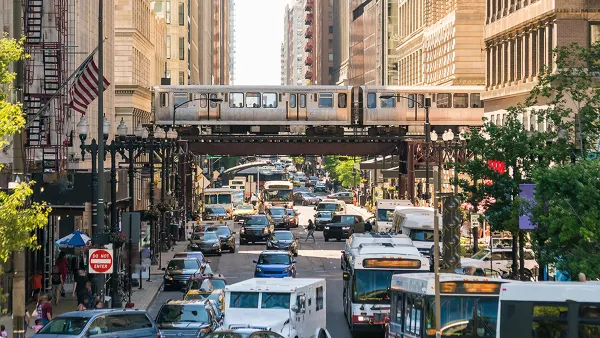The history of Seattle's opposition to car infrastructure is being commemorated while it's being made.

Knute Berger and Stephen Hegg write to update the history of Seattle's "ramps to nowhere"—the vestiges of the city's mid-20th century freeway building binge that came to a halt in a wave of environmental activism in 1972.
The most famous example of ramps to nowhere, and the subject of this exploration, are the remnants of the R.H. Thomson Expressway.
R.H. Thomson Expressway on and offramps had been built when the Evergreen Point Bridge — the State Route 520 floating bridge — was built in the early 1960s. They just sat waiting for the expressway to be attached. But they stood unconnected, like ancient ruins or garden follies. Instead of carrying cars, kids would jump off them into Lake Washington during warm summer days. They were used by swimmers and sunbathers. They were very expensive diving boards.
As noted by Berger and Hegg, the R.H. Thompson Expressway ramps to nowhere have taken on a symbolism attached to the civic activism that halted construction of the project. In the past, residents have advocated for the preservation of the ramps to commemorate those efforts. According to the article, one ramp will remain standing for that purpose, but the rest are coming down.
In a bit of synchronicity between past and present, the city of Seattle is currently debating the need to expand some of its existing bridges for cars, as highlighted in a separate article by the editorial board of The Urbanist. The Magnolia Bridge, "[s]erving a peninsula with some 20,000 residents and two other bridges over the Interbay railyard," is the perfect example of the tendency for elected officials in Seattle to push for car infrastructure as a matter of regional and even national priority (in that way, Seattle-area politicians certainly resemble politicians in other corners of the country). Clearly, the editorial board of The Urbanist aims to follow in the footsteps of their anti-highway forebears.
FULL STORY: An end to Seattle’s ramps to nowhere

Planetizen Federal Action Tracker
A weekly monitor of how Trump’s orders and actions are impacting planners and planning in America.

Chicago’s Ghost Rails
Just beneath the surface of the modern city lie the remnants of its expansive early 20th-century streetcar system.

Amtrak Cutting Jobs, Funding to High-Speed Rail
The agency plans to cut 10 percent of its workforce and has confirmed it will not fund new high-speed rail projects.

Ohio Forces Data Centers to Prepay for Power
Utilities are calling on states to hold data center operators responsible for new energy demands to prevent leaving consumers on the hook for their bills.

MARTA CEO Steps Down Amid Citizenship Concerns
MARTA’s board announced Thursday that its chief, who is from Canada, is resigning due to questions about his immigration status.

Silicon Valley ‘Bike Superhighway’ Awarded $14M State Grant
A Caltrans grant brings the 10-mile Central Bikeway project connecting Santa Clara and East San Jose closer to fruition.
Urban Design for Planners 1: Software Tools
This six-course series explores essential urban design concepts using open source software and equips planners with the tools they need to participate fully in the urban design process.
Planning for Universal Design
Learn the tools for implementing Universal Design in planning regulations.
Caltrans
City of Fort Worth
Mpact (founded as Rail~Volution)
City of Camden Redevelopment Agency
City of Astoria
City of Portland
City of Laramie





























